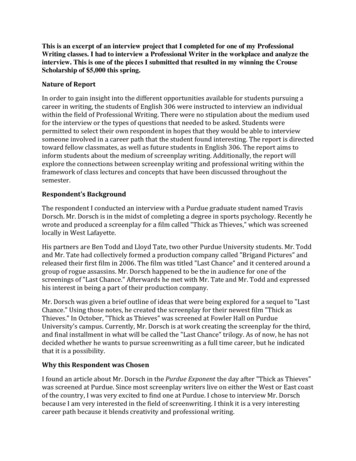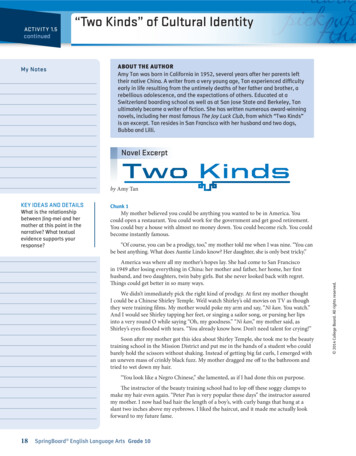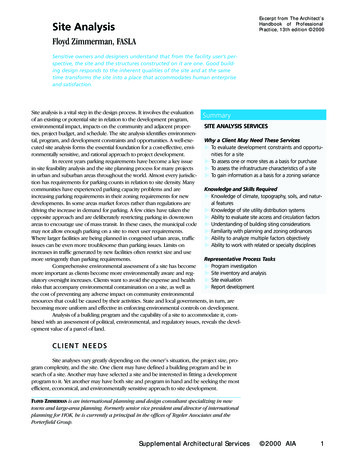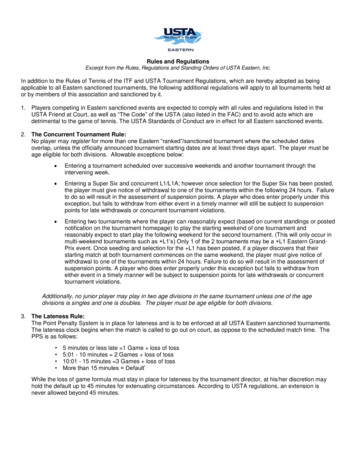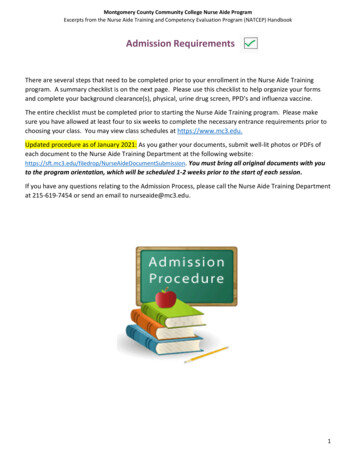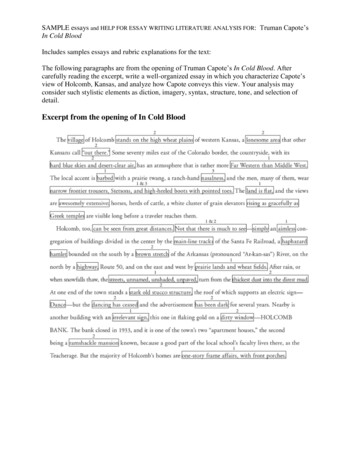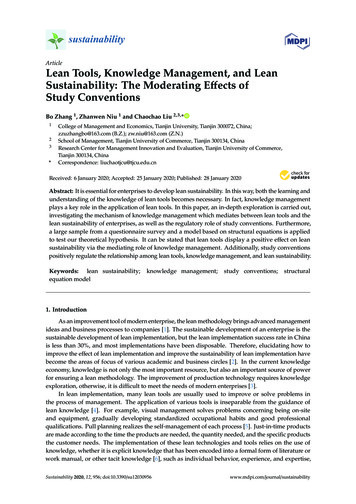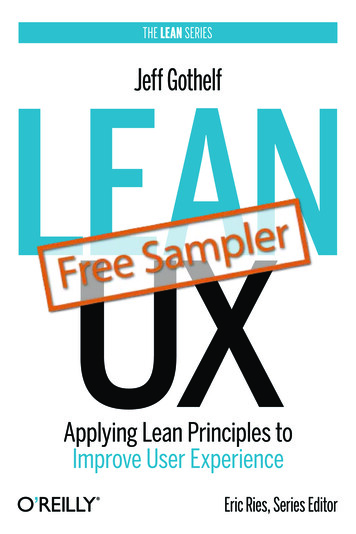
Transcription
Excerptfrom:LeanUX(DraftVersion)Contents ofLean UX:Applying Lean Principlesto Improve User ExperienceJeff Gothelf* Included in this sample.* PrefaceSection I: Introduction and PrinciplesChapter 1: Why Lean UX?Chapter 2: Principles of Lean UXSection II: Process* Chapter 3: Vision, framing and outcomesChapter 4: Collaborative designChapter 5: MVP’s and ExperimentsChapter 6: Feedback and ResearchSection III: Integrating with your organizationChapter 7: Integrating Lean UX and AgileChapter 8: Making organizational shifts107
Excerptfrom:LeanUX(DraftVersion)PrefaceThe biggest lie in software is Phase Two.If you've spent any time building digital products in the last 20years—regardless of your role—you've felt the sting of this lie.You set aside features and ideas for the next phase or work andthen they are gone—never to be heard from again. As a designer,I've had hundreds, if not thousands, of wireframes and workflowsend up in this same bucket.But did these ideas disappear because they were flawed? Did thefeatures that shipped actually meet customer and business goals?Or did the team simply run out of time? They never got to PhaseTwo.108
Excerptfrom:LeanUX(DraftVersion)In The Lean Startup, Eric Ries lays out his vision for how to ensurethe ideas that have the most value get the most resources. Themethod Ries promotes relies on experimentation, rapid iterationsof ideas, and evolutionary processes. The entire concept of PhaseTwo becomes moot.The junction of Lean Startup and User Experience design -- andtheir symbiotically beneficial coexistence -- is Lean UX.What is Lean UX and how is it different?The Lean principles underlying Lean Startup apply to Lean UX inthree ways. First, they help us remove waste from our UX designprocess. We move away from heavily-documented handoffs to aprocess that creates only the design artifacts we need to move theteam's learning forward. Second, they drive us to harmonize our"system" of designers, developers, product managers, qualityassurance engineers, marketers and others in a transparent, crossfunctional collaboration that brings non-designers into our designprocess. Last, and perhaps most important, is the mindset shift wegain from adopting a model based on experimentation. Instead ofrelying on a hero designer to divine the best solution from a singlepoint of view, we use rapid experimentation and measurement tolearn quickly how well (or not) our ideas meet our goals. In all ofthis, the designer's role begins to evolve towards designfacilitation—and with that we take on a new set of responsibilities.Besides Lean Startup, Lean UX has two other foundations: DesignThinking and Agile development philosophies. Design Thinkingtakes a solution-focused approach to problem-solving, workingcollaboratively to iterate an endless, shifting path toward;0 10.?4:9 ? B: 6 ?:B, / ; :/@.? 2:,7 A4, ;0.4K. 4/0,?4:9 109
Excerptfrom:LeanUX(DraftVersion)prototyping, implementation and learning steps to bring theappropriate solution to light. Agile re-focuses softwaredevelopment on value. It seeks to deliver working software tocustomers quickly and to adjust regularly to new learning along theway.Lean UX uses these foundations to break the stalemate between thespeed of Agile and the need for design in the product-developmentlifecycle. If you've struggled to figure our how UX design canwork in agile environments, Lean UX can help.Lean UX breaks down the barriers that have kept softwaredesigners isolated from real business needs on the one hand andactual implementation on the other. Lean UX not only brings us tothe table – it brings our partners in business and technology to thewhiteboard to work with us on the best solutions in an ongoingway.I once had a large pharmaceutical client who hired the agency Iworked for to redesign their e-commerce platform with the goal ofincreasing revenues by 15%. I was the lead interaction designer onour team. In the vacuum of our office, we spent monthsresearching the current system, supply chain, competitors, targetaudience and contextual use scenarios. We researched personasand assembled strategic models. I designed a new informationarchitecture for the product catalog and crafted a brand-newshopping and checkout experience.The project took months. And when the work was complete, wepackaged it all up into a Powerpoint deck. This was a formidabledeck – and it had to be, considering the 600k price tag! We went:A0 ?: ?30 .7409? :1K.0 ,9/ ;09? ,9 09?4 0 0423?-hour day going110
Excerptfrom:LeanUX(DraftVersion)over each and every pixel and word in that deck. When it was over,the client clapped. (They really did). We were relieved. They lovedit. And we never looked at that deck again.Six months after that meeting, nothing had changed on the client'ssite. I don't think they ever looked at that deck again, either.The moral of this story: Building a pixel-perfect spec might be aroute to rake in six-figure consulting fees, but it's not a way tomake a meaningful difference to a real product that is crucial toreal users. It's also not the reason that any designer got into theproduct design business. We got in to build valuable products andservices, not to write specs.Some teams I work with today create entirely new products orservices. They are not working within an existing productframework or structure. In "green-K07/ ; :50.? 7460 ?30 0 B0 , 0 simultaneously trying to discover how this new product or servicewill be used, how it will behave and how we are going to build it.It's an environment of continual change, and there isn't a lot of timeor patience for planning or up-front design.Other teams work with established products that were created withtraditional design and development methods. Their challenge isdifferent. They need to build upon existing platforms whileincreasing revenue and brand value. These teams usually havemore resources at their disposal than a ground-floor startup, butthey still have to use their resources efficiently—figuring out thebest way to spend those resources to build products and servicestheir customers actually want.111
Excerptfrom:LeanUX(DraftVersion)As I've learned to practice Lean UX, I've had to overcome the1007492 ?3,? B, 3:B492 B: 6 ?3,? B, @27D @9K94 30/ : "not ready." Working this way requires the support of a highfunctioning team. You need to know—as a team—that you're not2:492 ?: 20? 4? 423? ?30 K ? ?480 ,9/ ?3,? D:@J 0 ,77 B: 6492 together to iterate your way forward. I want you to gain thatconfidence, too. Within the pages of this book, I've distilled theinsights and tactics that have allowed me to create real success forproduct and business teams—and real satisfaction for customers.Who is Lean UX for?%34 -::6 4 K ? 1: 49?0 ,.?4:9 /0 4290 Bho know they cancontribute more and be more effective with their teams. But, it's,7 : 1: ; :/@.? 8,9,20 B3: 900/ -0?0 B,D ?: /0K90 ?304 products with their teams and to validate them with their customers.It's also for developers who understand that a collaborative teamenvironment leads to better code and more meaningful work. And,K9,77D 4? 1: 8,9,20 —managers of user-experience teams,project teams, business lines, departments and companies—whounderstand the difference a great user experience can make.What's in It for You?The book is set up in three sections. Section I provides anoverview and introduction to Lean UX and its founding principles.I lay out the reasons the evolution of the UX design process is socritical and describe what Lean UX is. I also discuss the underlying; 49.4;70 D:@J77 900/ ?: @9/0 ?,9/ ?: 8,60 0,9 &( @.0 1@7Section II focuses on Process. Each chapter takes a step in the0,9 &( .D.70 ,9/ /0?,47 .70, 7D 3:B ?: /: 0,.3 ?0; ,9/ B3D 4?J important. I also share examples of how I and others have donethese things in the past.112
Excerptfrom:LeanUX(DraftVersion)The last part of the book, Section III, tackles the integration ofLean UX practices into your organization. I also discuss the role ofLean UX within a typical Agile development environment. Finally,I discuss the organizational shifts that need to take place both at thecorporate level, the team level, and at the individual contributorlevel for these ideas to truly take hold.My hope is that this book will deliver a wake-up call to userexperience designers still waiting for "Phase Two." While the book4 K770/ B4?3 ?,.?4. ,9/ ?0.394 @0 ?: 307; 0A:7A0 D:@ ; :.0 0 Lean UX is, at its core, a mindset. As you travel down this path, I'dlove to hear about your successes, challenges and failures so thatwe can keep that mindset current, relevant and productive. Emailme with your thoughts at jeff@jeffgothelf.com . I look forward tohearing from you.[Jeff]P.S. - For the purposes of this book, the terms Interaction Designand UX /0 429 , 0 @ 0/ ?: /09:?0 ,77 ?30 K07/ ,9/ 7,-07 ?3,? currently reside under the User Experience and Design umbrella.(If, Dear Reader, you call your specialty User Interface Design,Information Architecture, Experience Architecture or any of themyriad 9,80 .@ 09?7D L:,?492 ,-:@? 69:B ?3,? ?30D , 0 explicitly included in these terms.)113
Excerptfrom:LeanUX(DraftVersion)CHAPTER 3Vision, Framing & Outcomes"Ifitdisagreeswithexperiment,it'swrong."- rld- ‐- ‐tocreateanoutcome.Westartwithassumptions114
hemaintoolofoutcome- llcreateasinglesign- numberofnewsign- fthefollowingelements: Assumptions- ‐- ‐ahigh- ses- ‐- tation.115
Excerptfrom:LeanUX(DraftVersion)Outcomes- ‐- nvalidateourhypotheses.Theseare oftenquantitativebutcanalsobequalitative. believewilldrivetheoutcomesweseek.Features- ‐- tail.116
oingthisasateam,yougiveeveryteammember- ‐- ‐designerandnon- ‐designeralike- ‐- katonewaytoruntheassumptionsexercise.117
Excerptfrom:LeanUX(DraftVersion)METHOD: Declaring presented- ‐- oductisbeingused118
oundedandaligned.119
Excerptfrom:LeanUX(DraftVersion)Problem Statement moresuccessfulbasedon[thesemeasurablecriteria]?120
saref
Lean UX within a typical Agile development environment. Finally, I discuss the organizational shifts that need to take place both at the corporate level, the team level, and at the individual contributor level for these ideas to truly take hold. My hope is that this book will deliver a wake-up call to user
